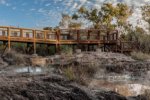|
 Microfluidic single-cell genomics Microfluidic single-cell genomics
Dissecting microbial dark matter with single-cell genomics, the recovery of genomes from individual cells, allows us to understand microbial communities on the level that represents the basic units of life – the cell.
Read more: microfluidic single-cell genomics
|
 The Brisbane River microbiome The Brisbane River microbiome
The health of the highly urbanised Brisbane River is important for the City of Brisbane and the entire Moreton Bay region. Investigating the river microbiome and its changes over time will help us understand the role of these microbes in river health.
Read more: Brisbane river microbiome
|
 Australian Hot Spring ecosystem Australian Hot Spring ecosystem
Natural thermal springs are produced by geothermally heated groundwater and provide opportunities for studying microbes that may represent analogues of life on ancient Earth or even other planets. In this project, we will characterise the microbial communities in a recently explored Australian hot spring ecosystem.
Read more: Exploring the unique microbial community of an Australian Hot Spring ecosystem
|
 Hidden microbes & viruses in North Stradbroke Island aquifers Hidden microbes & viruses in North Stradbroke Island aquifers
North Stradbroke Island is a small sand island with many groundwater bodies. The microbes and viruses hidden in these aquifers have remained mostly unexplored. You will use metagenomics and viromics to explore this hidden treasure.
Read more: North Stradbroke Island aquifers
|
 Microbial degradation of marine plastic debris Microbial degradation of marine plastic debris
Using culture independent techniques, we aim to identify microbes and enzymes involved in polypropylene, polystyrene and polyethylene biodegradation in marine habitats.
Read more: marine plastic debris
|
 Superworms can break down plastic waste Superworms can break down plastic waste
Superworms can survive on a diet of solely polystyrene, and can act like mini recycling plants, shredding the polystyrene with their mouths and then feeding it to the bacteria in their gut.
Read more: Superworms
| | | | | |